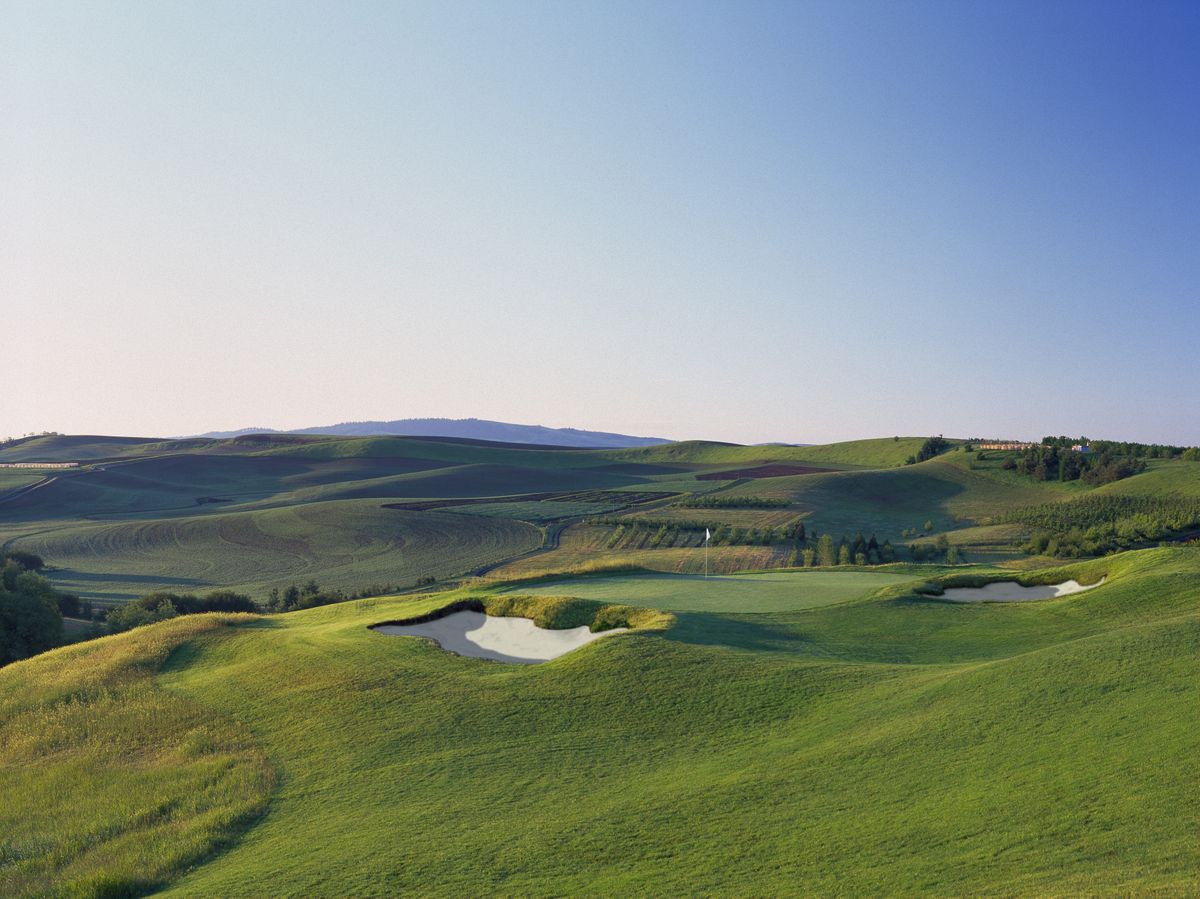Palouse Ridge a peak experience
New links-style course rambles over rolling hills on east side of WSU campus

PULLMAN – From the plush, deep green and crazily tilted bluegrass fairways, dramatically outlined by thick growths of winter wheat, to the nasty, jagged-edged sand traps rimmed by native grasses, John Harbottle III got it right.
So it was with an obvious sense of pride that the Tacoma-based golf course architect unveiled his latest creation, Palouse Ridge Golf Club, to members of the media earlier this month.
What greeted those in attendance was a quickly maturing and immensely challenging championship layout that unfolds across 315 acres of rolling terrain on the east end of the Washington State University campus and offers majestic views of the surrounding mountains, hills and wheat fields from nearly every tee box.
The course will serve as the home venue for the WSU men’s and women’s golf teams and is already scheduled to host the 2012 Pacific-10 Conference women’s championships.
“The feedback we’ve been getting on the course has been amazing,” said head professional Jeremy Wexler. “It’s a true, championship-style course capable of hosting a Pac-10 championship and, hopefully, even an NCAA championship.
“The people who have played it so far have been very impressed with everything from its playability to its great views and variety of holes.”
Palouse Ridge, a par-72 links-style layout, which measures a hefty 7,305 yards from the deepest of its five sets of tee boxes, is a perfect match for its rural location. The winter wheat, which was planted in an effort to curb hillside erosion during the grow-in period, waves majestically in the winds that so often scour the rolling contours of the region, but will probably be a one-year wonder.
Once the course has matured, native grasses will likely grow in to define the fairways and provide stiff penalties for errant tee shots.
But for now, the wheat adds immensely to the course’s rugged, unrefined character that seems to be a perfect fit for the region.
“I think that’s what Harbottle was going for,” Wexler added. “He wanted to create a course that not only offers a great golfing experience but kind of blends in, naturally, with its surroundings, too.”
Constructed at a cost of $12.3 million – which includes a 7,000 square-foot clubhouse overlooking the 18th green, a double-ended driving range with target greens, two practice greens, an expansive chipping and sand-play area and a 120-yard practice hole that will be reserved for WSU’s golf teams – Palouse Ridge is scheduled to stage a “soft opening” today, limiting the number of daily rounds to about 80 as the course continues to mature.
The grand opening, according to Wexler, will take place on Aug. 29, at which time the clubhouse is expected to be fully stocked and operational, as well.
WSU officials are hoping Palouse Ridge will eventually become a destination course, luring golfers from all over the planet. And there is certainly no evidence to suggest the course, itself, won’t hold up its end of the deal when it comes to achieving that goal.
Even playing as long as it does from the tips, Palouse Ridge should offer a satisfying experience to golfers of all skill levels, provided they select the proper tee boxes from which to play. Despite the minimal amount of trees that come into play, the rolling terrain helps give golfers a sense there is no one else on the course on many holes, much like the acclaimed Circling Raven Golf Club in Worley, Idaho.
The T-1 bentgrass greens are smooth, firm and fair, but not overly large. And because most tend to be either wide and shallow or narrow and deep, they demand well-perceived and well-executed approach shots.
The first hole, a 463-yard par-4 that plays into the prevailing wind, features a view of WSU’s most enduring landmark, the Bryan Clock Tower, which also serves as an aiming point off the tee.
“It’s a great opening hole, and, again, that’s what Harbottle wanted,” Wexler said. “He wanted to let people know exactly where they are when they step to that first tee, so he started them off with a view of the campus skyline.”
Among the other holes generating a lot of early buzz, according to Wexler, are the scenic par-4 third, the lengthy par-5 10th and the short and driveable – from the upper tees, at least – par-4 15th, featuring three intimidating crossing bunkers that occupy the prime landing area off the tee and split the fairway, forcing golfers not willing to risk driving the green to commit their tee shots to a specific line and distance of carry.
The third hole, which measures 484 yards from the back, or Crimson, tees, boasts an elevated tee box that sits more than 90 feet above a narrow fairway that angles to the left. It offers stunning views of the surrounding mountains and fields, and seems destined to establish itself as one of the premier four-shot holes in the region.
The 10th is a 626-yard monster that also includes jaw-dropping views from the tee box. Despite playing downhill and, in most instances, downwind, the sheer length of this left-to-right dogleg hole will make it unreachable in two for all but the longest of hitters.
The 540-yard, par-5 ninth is another risk-reward gem that forces golfers to decide how much of the wetlands that guard the left side of the fairway they want to cut off.
Adding the uniqueness of Palouse Ridge is the fact that the back nine, which plays to a par of 36, features three par-3, three par-4s and three par-5s.
“People have told us they really like the fact that no two holes are similar,” Wexler said. “And everyone seems to have their own personal favorite.”
Which is another indication that John Harbottle III got it right.